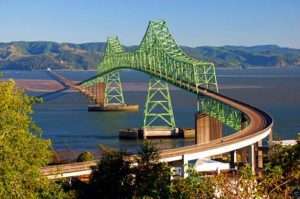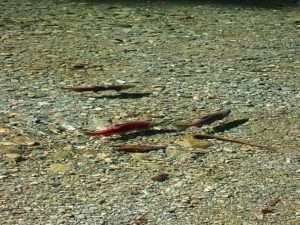
I live within sight of the Willapa Hills. This mountain range, a contemporary of the Oregon Coast Range, stretches from the north bank of the Columbia River to the Olympic Mountains. As these are very old mountains–they began forming about 60 million years ago–they aren’t as tall and impressive as the Cascades. But they’re still a gorgeous sight, especially when snow falls at a low enough elevation to dust the gentle peaks.
They’re also one of the most heavily denuded mountain ranges on the west coast. All but a few small patches are in private hands and have been clearcut at least once. Old logging towns dot the area; as logging companies like Weyerhauser have sent timber overseas to be processed, most sawmills in the U.S. have close down in recent decades. While the northern spotted owl (Strix occidentalis caurina) became the scapegoat in the 1990s, more jobs have been lost due to corporate decisions like these than to the protection of the last scraps of old-growth forest.
Driving across the Astoria-Megler bridge from Oregon, the beauty of the Columbia River Estuary is marred by bare, scarred hillsides everywhere you look on the Washington side. And the damage just continues as you head north up 101, which offers close-up views of land torn apart once again by recent clearcuts.
 The main concern most people have with regards to clearcuts is the loss of the trees; after all, those are the most obvious component of the forest. But the damage goes much deeper. Entire ecosystems are bulldozed to bare dirt to make it easier for heavy machinery to gather the trees; killing numerous living beings and severely compacting the soil.
The main concern most people have with regards to clearcuts is the loss of the trees; after all, those are the most obvious component of the forest. But the damage goes much deeper. Entire ecosystems are bulldozed to bare dirt to make it easier for heavy machinery to gather the trees; killing numerous living beings and severely compacting the soil.
That soil is then left defenseless, shorn of its rich, protective layers of vegetation and duff. The Willapa Hills can get upwards of 100 inches of precipitation a year, almost all of it as rain. Climate change has led to more severe weather that dumps larger amounts of rain in short periods of time.
A healthy, mature forest can mitigate some of the effects of these downpours as vegetation slows the velocity of raindrops, and the complex, layered soil with its cover of duff absorbs the water. A clearcut lacks these protections, which means every time it rains, tons of topsoil wash off the bare hills. It takes decades for trees and other vegetation to return to a point where they can effectively protect the soil, but by that point an incredible amount of valuable soil has been lost permanently, and will take many centuries to build back up–assuming the land isn’t just clearcut again when the trees are a few decades old.
This, of course, is terrible for the local ecosystem. Any plants and fungi that return to that area are going to be dealing with badly depleted soil with fewer nutrients and a diminished soil microbiome. On a much wider scale, soil is an incredibly important carbon sink, and clearcuts severely reduce the soil’s ability to hold carbon. This is in addition to all the carbon released and produced through the act of clearcutting in the first place.
 But it’s not just the land affected by soil erosion. All that soil flows into streams and other waterways. Normally the streams that cascade down the Willapa Hills have rocky beds, full of gravel deposits used by salmon to lay their eggs, and offering shelter to a variety of other aquatic life. When soil washes down into the stream, some of it settles into the gravel, smothering it and anything living in it, to include salmon eggs. This directly leads to a significant decline in salmon and other aquatic wildlife populations. Some streams have been so badly damaged that their longtime salmon runs have gone extinct.
But it’s not just the land affected by soil erosion. All that soil flows into streams and other waterways. Normally the streams that cascade down the Willapa Hills have rocky beds, full of gravel deposits used by salmon to lay their eggs, and offering shelter to a variety of other aquatic life. When soil washes down into the stream, some of it settles into the gravel, smothering it and anything living in it, to include salmon eggs. This directly leads to a significant decline in salmon and other aquatic wildlife populations. Some streams have been so badly damaged that their longtime salmon runs have gone extinct.
Clearcut forests are the most obvious source of soil erosion, but the same problems happen anywhere the soil is laid bare. Millions of acres of prairie have been destroyed in the past couple of centuries to create farmland in the Midwest; grassland soils are even better carbon sinks than those in forests. And while lawns may have a rudimentary covering of one species of grass (and perhaps a few weeds in the absence of spraying), the soil underneath is usually quite unhealthy and not sequestering carbon the way a natural grassland would. (Lawns, by the way, cover over 63,000 square miles of the United States and are the country’s largest cultivated crop.)
So what can we do about all this? We can start by putting public pressure on logging companies and other entities involved in destroying intact native ecosystems like forests and grasslands. While we do still need timber, there are more sustainable alternatives to clearcutting that are also more carbon-friendly.
It’s also important to protect what native ecosystems remain, especially those that are relatively undamaged by development, invasive species, and other deleterious factors. And habitat restoration, even on a small scale, can make a big difference both locally and as part of a wider network of restoration projects in backyards and on balconies.
Finally, keep sharing news stories and other information about soil erosion and solutions. The more people know about this important ecological topic, the better decisions we can all make both as individuals and as part of a society.
